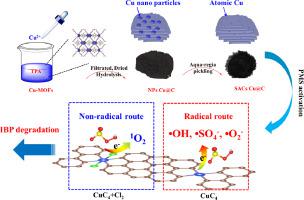当前位置:
X-MOL 学术
›
Sci. Total Environ.
›
论文详情
Our official English website, www.x-mol.net, welcomes your
feedback! (Note: you will need to create a separate account there.)
Activation of peroxymonosulfate for degrading ibuprofen via single atom Cu anchored by carbon skeleton and chlorine atom: The radical and non-radical pathways
Science of the Total Environment ( IF 8.2 ) Pub Date : 2022-11-08 , DOI: 10.1016/j.scitotenv.2022.160097 Weirui Chen 1 , Xukai Li 2 , Xipeng Wei 3 , Gaozu Liao 2 , Jing Wang 2 , Laisheng Li 2
Science of the Total Environment ( IF 8.2 ) Pub Date : 2022-11-08 , DOI: 10.1016/j.scitotenv.2022.160097 Weirui Chen 1 , Xukai Li 2 , Xipeng Wei 3 , Gaozu Liao 2 , Jing Wang 2 , Laisheng Li 2
Affiliation

|
Single atomic Cu catalysts (SACs Cu@C) anchored by carbon skeleton and chlorine atom was synthesized by hydrolyzing Cu-MOFs and then pickled by aqua-regia to remove Cu nanoparticles (NPs Cu). Comparative characterizations revealed that SACs Cu@C was a hierarchically porous nanostructure and Cu dispersed uniformly throughout the carbon skeletons. With less active components, SACs Cu@C behaved better in activating PMS over NPs Cu@C on ibuprofen removal (91.3 % versus 30.2 % in 30 min). Two Cu coordination environments were found by EXAF and DFT calculation, including four-coordinated Cu with 4C atoms and six-coordinated Cu with 4Cu and 2Cl atoms. The obvious interfacial electron delivery between PMS and SACs Cu@C was found, which was enhanced by Cl atom. Cu(I)/Cu(II) redox cycle would donate electron to peroxy bond of PMS for generating 4 − 2 − . But electron transferred in opposite direction when PMS bonded to Cu atom through its terminal oxygen atom in sulfate, which formed 1 O2 . IBP degradation proceeded through both radical and non-radical route. IBP degradation was inhibited with the presence of TBA, methanol and furfuryl alcohol but accelerated by p-BQ, which could accelerate
中文翻译:

通过碳骨架和氯原子锚定的单原子 Cu 活化过氧一硫酸盐降解布洛芬:自由基和非自由基途径
通过水解 Cu-MOF 合成由碳骨架和氯原子锚定的单原子 Cu 催化剂 (SACs Cu@C),然后用王水酸洗去除 Cu 纳米颗粒 (NPs Cu)。比较表征表明,SACs Cu@C是一种分层多孔纳米结构,Cu 均匀分散在整个碳骨架中。在活性成分较少的情况下,SAC 在激活 PMS 方面的表现Cu@C优于 NPs,Cu@C去除布洛芬时 (30 分钟内为 91.3% 对 30.2 %)。通过 EXAF 和 DFT 计算得到两个 Cu 配位环境,包括 4C 原子的 4 位 Cu 和 4Cu 和 2Cl 原子的 6 位 Cu。发现 PMS 和 SACs 之间明显的界面电子传递Cu@C,这被 Cl 原子增强。Cu(I)/Cu(II) 氧化还原循环会将电子提供给 PMS 的过氧键以生成 OH、SO4− 和 O2−。但是当 PMS 通过其硫酸盐中的末端氧原子与 Cu 原子键合时,电子会向相反方向转移,形成 1O2。IBP 降解通过自由基和非自由基途径进行。TBA、甲醇和糠醇的存在抑制了 IBP 降解,但 p-BQ 加速了 IBP 降解,从而加速了 OH 的产生。扣除 2 条降解途径。这项研究为设计用于 PMS 活化的催化剂提供了新的见解。
更新日期:2022-11-08
中文翻译:

通过碳骨架和氯原子锚定的单原子 Cu 活化过氧一硫酸盐降解布洛芬:自由基和非自由基途径
通过水解 Cu-MOF 合成由碳骨架和氯原子锚定的单原子 Cu 催化剂 (SACs Cu@C),然后用王水酸洗去除 Cu 纳米颗粒 (NPs Cu)。比较表征表明,SACs Cu@C是一种分层多孔纳米结构,Cu 均匀分散在整个碳骨架中。在活性成分较少的情况下,SAC 在激活 PMS 方面的表现Cu@C优于 NPs,Cu@C去除布洛芬时 (30 分钟内为 91.3% 对 30.2 %)。通过 EXAF 和 DFT 计算得到两个 Cu 配位环境,包括 4C 原子的 4 位 Cu 和 4Cu 和 2Cl 原子的 6 位 Cu。发现 PMS 和 SACs 之间明显的界面电子传递Cu@C,这被 Cl 原子增强。Cu(I)/Cu(II) 氧化还原循环会将电子提供给 PMS 的过氧键以生成 OH、SO4− 和 O2−。但是当 PMS 通过其硫酸盐中的末端氧原子与 Cu 原子键合时,电子会向相反方向转移,形成 1O2。IBP 降解通过自由基和非自由基途径进行。TBA、甲醇和糠醇的存在抑制了 IBP 降解,但 p-BQ 加速了 IBP 降解,从而加速了 OH 的产生。扣除 2 条降解途径。这项研究为设计用于 PMS 活化的催化剂提供了新的见解。

































 京公网安备 11010802027423号
京公网安备 11010802027423号